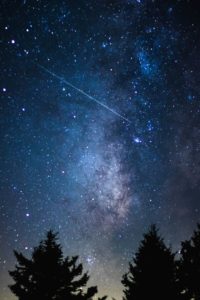 Alas, this week it’s been too cloudy to see the Leonid meteor shower at all.
Alas, this week it’s been too cloudy to see the Leonid meteor shower at all.
The Leonids are one of the most famous and reliable meteor showers seen in the Northern Hemisphere. They peak in mid-November and are some of the fastest meteors seen. The Leonids are famous for their fireballs, which are larger, longer-lasting meteors, and their earthgrazers, which occur low to the horizon, with a long and colorful tail.
Meteors are caused from cosmic debris streaming from the tail of a comet; as the comet passes near the sun, some of its ice evaporates, creating a “dust trail” of sublimated fragments. The dust trail is affected by the Earth’s gravity and that of other planets. Most meteors are smaller than a grain of sand and burn up over fifty miles from the earth’s surface, although some survive their scorching atmospheric entry and impact the ground.
Meteors are named not after the parent comet (the Tempel-Tuttle in this case) but rather the nearest constellation or bright star with a Greek or Roman letter. Thus, the Perseids are named after the constellation Perseus, he who beheaded the Gorgon Medusa, and vanquished the sea serpent to save the Princess Andromeda, and the Leonids after the constellation Leo, the lion.
A meteor shower may contain up to a thousand meteors an hour, but a meteor storm may peak at over two hundred thousand meteors an hour! A storm is caused by a young meteor stream, with the mass still concentrated near the parent’s orbit. The Leonid meteor shower peaks on November 17, but every thirty-three years, the Leonids exhibit a meteor storm. The last one was in 2002, but during the shower of ’66, they were said to fall like rain—in 1833, there were over one hundred thousand meteors an hour, enough that Abraham Lincoln remarked on the event years later, and the Lakota nation reset their calendar. A meteor shower kicks up enough dust from impacts on the Moon that its “sodium tail” is visibly altered. Mark your calendars for 2035!
The Leonids are featured in media in the novel Blood Meridian by Cormac McCarthy, William Faulkner’s short story, “The Bear,” and T.S. Eliot’s poem, “East Coker,” as well as episodes of The Big Bang Theory and The Brokenwood Mysteries. They are referred to as “the Litleonids” in the video game Pokémon Omega Ruby and Alpha Sapphire.
I’m bummed to miss the celestial fireworks, but at least the cloudy skies are good for my writing schedule! And as I work on the soon-to-be renamed Mistress of None, I find myself thinking “just one more” about The Helios Series, thanks to the pleas of a fan who wants Cynthia (New Heights, Submerged Hopes) to have her own story.
Recent Comments